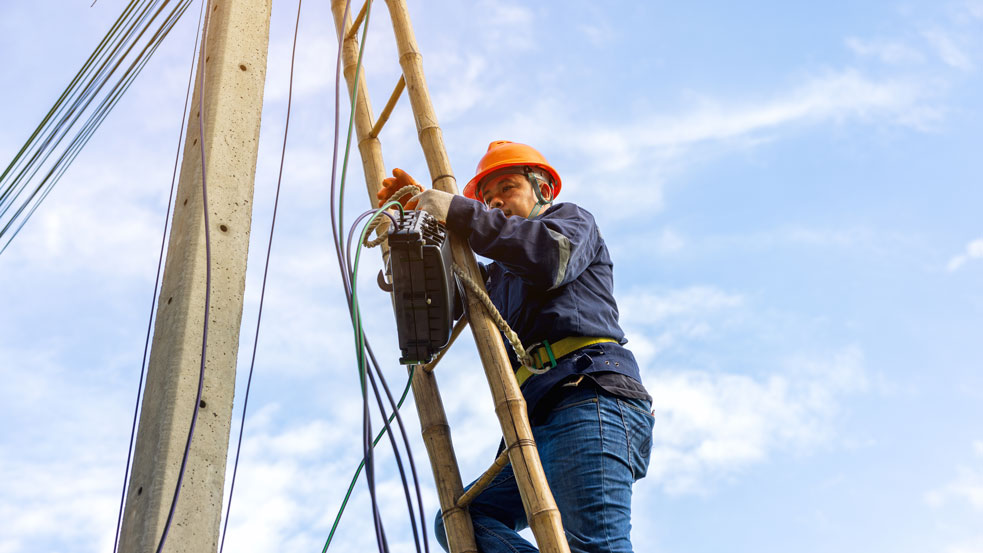Not All Video Is Created Equal

It’s no secret that video conferencing is a productivity powerhouse around the office. For users, it helps improve employee engagement and creates a better sense of community among globally dispersed teams. But the IT departments implementing the solution will find some unique benefits of their own. An all-in-one solution like Lifesize can replace legacy audio-only conferencing services and provide audio, video and web conferencing in a single application that tightly integrates with conference room cameras and touchscreen conference phones. It’s a simple solution for users to use and for IT to manage. Just remember that not all video is created equal.
There are two main differences between the video clips you watch on the internet and the live video conferences you hold at the office. For one, streaming video clips (your standard cat video variety) are designed to download portions of the footage ahead of time to make up for network instability during the course of the playback. The other is that you almost never raise an IT helpdesk ticket because your YouTube video took a few extra seconds to buffer. Video conferencing, on the other hand, relies on packets of data being sent and received consistently and in real time to ensure that the call remains clear, with every inflection, gesture and word correctly transmitted.
When researching a video conferencing solution, it’s important to review your own network topology to see if any optimizations could be made to ensure the best possible experience for your end users. It should be noted that most deployments are ready for and run video perfectly well without any modifications. The tips in this guide are designed to help you get the most out of your network by outlining some key considerations for your bandwidth, network architecture and network security.
How Much Bandwidth Do I Need?
The first question most IT admins have about video conferencing isn’t about 1080p resolution or if it supports the latest emoji packs; it’s all about bandwidth requirements. When we break it down, a point-to-point video call between two users or locations will use about 2 Mbps down and 2 Mbps up of internet bandwidth on both sides — since both groups are sending and receiving packets of data during a live call. These requirements are designed to make sure the call runs smoothly and with the best quality possible (or from IT’s perspective, to minimize the chance of a quality-related helpdesk ticket being submitted).
But unless you deploy a single video conferencing room with a strict “one at a time” rule, you’re likely to run into situations with concurrent calling. By the way, this is a very good thing, both for adoption and productivity. Aside from maybe security alarm systems, high utilization is generally good. According to our data about overall Lifesize service usage, a typical organization should account for at least 5 percent concurrent utilization, or five simultaneous calls for every 100 users sharing an internet connection. Organizations that think they’ll use the service significantly more can factor that in. It’s also important to build in an additional 10 percent of overhead to account for call signaling and packetization.
Now that you have a baseline requirements number, it’s time to look at your current bandwidth allotment and current load. Unused bandwidth can be an expensive luxury, so most companies prefer to purchase the exact amount they need. If your video bandwidth requirement fits inside your unused allocation, you’re good to go. If not, it may be worth a call with your ISP to upgrade your internet pipe for the best quality.
Handling Internet Imperfections
Like most things, the public internet has its imperfections. Even if your office is perfectly equipped with the recommended amount of bandwidth, there are still times when packets can be dropped due to internet failings — luckily, we’ve planned ahead. Lifesize incorporates three levels of packet loss and internet imperfection handling to keep your conversations running smoothly.
Error Concealment
Lifesize runs the very efficient Opus audio codec with built-in error concealment, offering no noticeable artifacting at up to 20 percent packet loss. Video transmissions are also built with error concealment to seamlessly rebuild dropped data using the last known frames and pieces (called micro blocks). Our error concealment technology is the first line of defense and has the ability to mask dropped packets with almost no visible or audible change.
Error Correction
In the event of a large data loss, error correction will kick in to mathematically rebuild and fill in gaps based on the most recent frames of data. In these instances, audio is prioritized to maintain the flow of the conversation while the data is recovered.
Rate Control
Lifesize is built with the ability to dynamically downspeed a call to adjust for bandwidth limitations. If you are not able to send or receive the recommended 2 Mbps, the call will dynamically adjust your resolution to make the most of the available bandwidth. This will not affect other participants on the call who are able to send and receive 2 Mbps; they will continue to experience the call at full quality. Like error correction, rate control also prioritizes audio in the event of internet instability.
The Lifesize cloud architecture is built to rely as little on the public internet and as little on your bandwidth as possible. When you have Lifesize calls or meetings with participants located around the world, instead of traversing the entire distance on the public internet, the call is routed to the nearest IBM SoftLayer PoP (point of presence), where it jumps on their ultrafast, managed fiber network to navigate the globe. The call isn’t constantly hopping among different providers like it would on the public internet, which would increase latency and produce a much lower-quality call. The Lifesize and IBM Cloud relationship is designed to take the daily maintenance and connectivity reliability off of your IT team and give you the best possible video quality.
![]()
Real-Time System Health Monitoring
Lifesize Icon Health Monitoring utilizes data analytics to proactively alert your IT team to potential errors detected in the network. Upon enablement, you’ll get alerts for anything from disconnected cables to PBX registration errors and instances of excessive packet loss. Learn more.
Video Network Architectures
Like bandwidth, your network topology can have a positive, or negative, impact on your overall video experience. Below, we’ve outlined the main types of network architectures that we regularly encounter. Depending on factors like the industry and size of your company, there may be recommendations or requirements for improving video traffic through your network.
 Small and Medium Business Networks
Small and Medium Business Networks
Small companies with one or two office locations typically have simple IT environments. They may run independent networks with no interconnections, or they may deploy IP-VPN technologies like Internet Protocol Security (IPsec) VPN tunnels to interconnect their offices and users via VPN clients. These networks usually have localized breakouts to the internet at each office location.
This network architecture lends itself well to the use of cloud-based solutions, as instead of having to traverse a WAN (wide area network) connection to reach the internet, the path is much shorter to the edge of the network. This is particularly important for real-time applications like video as fewer hops often mean less latency.
Medium, Large and Enterprise Networks
Larger organizations typically have some kind of WAN that spans multiple offices or even continents. They may deploy a mixture of IP-VPN and MPLS connectivity interconnecting these sites but generally do not have local internet breakouts. Instead, these networks often deploy centralized or regional breakouts co-located with other infrastructure and storage solutions.
This means that users who make calls from offices without an internet breakout will find their traffic routed across the corporate WAN links, which are often dimensioned to provide minimum acceptable performance due to high cost. This can have a negative impact on call experience if the WAN links are not suitably provisioned with enough bandwidth to support your video traffic. Adding Quality of Service (QoS) to the networks can help prioritize the traffic traversing these links, but this only really helps when links are already becoming congested or so heavily utilized that packet loss is occurring.
Offloading bandwidth-hungry and latency-intolerant real-time traffic at the local or regional office is less demanding on WAN links. And since it’s often more cost-effective to expand internet bandwidth than WAN connectivity, using “the cloud” to carry your real-time communication traffic is a logical approach and might be worth considering for the future, if not today.
 Your MPLS and IPsec solutions may be fine for connecting network drives, but at the end of the day, if it takes a couple extra minutes to send a file, it’s not a big deal. By contrast, the real-time nature of video communications is very intolerant of any loss or any delay. For video, a delay greater than 200 ms is too long.
Your MPLS and IPsec solutions may be fine for connecting network drives, but at the end of the day, if it takes a couple extra minutes to send a file, it’s not a big deal. By contrast, the real-time nature of video communications is very intolerant of any loss or any delay. For video, a delay greater than 200 ms is too long.
1. IPsec effectively wraps video data packets in additional security data packets, significantly bloating the size of the call and reducing the quality.
2. MPLS pipes are usually significantly smaller than the public internet pipe, basically putting a bottleneck on the network, which could ultimately risk the quality of your video calls.
3. With individual public internet circuits at each office, you can offload the demanding real-time video traffic from your own WAN by taking advantage of the global, high-bandwidth, low-latency connectivity offered by Lifesize and the IBM SoftLayer network
A Secure Foundation for Secure Video Calling
The early days of video conferencing required on-premises hardware that created a two-way street of information going in and out of your private network, with inbound traffic potentially opening you up to massive security issues. With Lifesize, we’ll never ask you to open inbound ports from the public internet to your private network. We won’t ask you to alter your internet-facing security posture, and we won’t make you spend more than you need to for security peace of mind. Instead, our architecture allows you to keep your Lifesize room systems and client software safely behind your firewall and manages firewall traversal through our global calling nodes.
Lifesize room systems and client software do not require any firewall ports to be opened inbound from the internet. There’s also no need for static public IP addressing or complicated static NAT (network address translation) and port-forwarding firewall configurations. Lifesize only makes use of outbound TCP/UDP connections for call setup and media. These TCP/UDP connections are always initiated by the Lifesize endpoint or client software in order to establish pinholes and dynamic port address translations. These connections are always directed to one of our global calling nodes on a specific list of published host IP addresses allowing for tightly crafted firewall rules.
Detailed information about our compliance certifications, in-meeting security features, authentication and privacy policies can be found in our Lifesize Security Overview document. These are your top-secret conversations we’re talking about, so we don’t take security lightly.
Where the Network Ends
As IT pros, we can do our prep work, maximize our bandwidth and plumb all our lines perfectly, but in the end, we must all come to terms with the fact that our control has a defined limit. That’s why it’s so important to be able to trust your provider to build a service that runs as efficiently as possible to support the widest range of scenarios. From the teleworkers connecting from their home offices to the traveling sales force logging in from the haziest public WiFi networks around the globe, Lifesize is designed to support your team collaboration on the broadest range of devices and network conditions. Error concealment and correction were developed to help remedy network imperfections, and audio-only options are available with local dial in numbers in over 60 countries for truly poor networks unable to support a video feed.
For more information on topics like network readiness and Lifesize cloud architecture, check out the Lifesize Community. The Community is a place where thousands of customers, partners and Lifesizers come together to share, chat, geek and grok Lifesize. We can even arrange an onsite visit to do a full network assessment and optimization.




